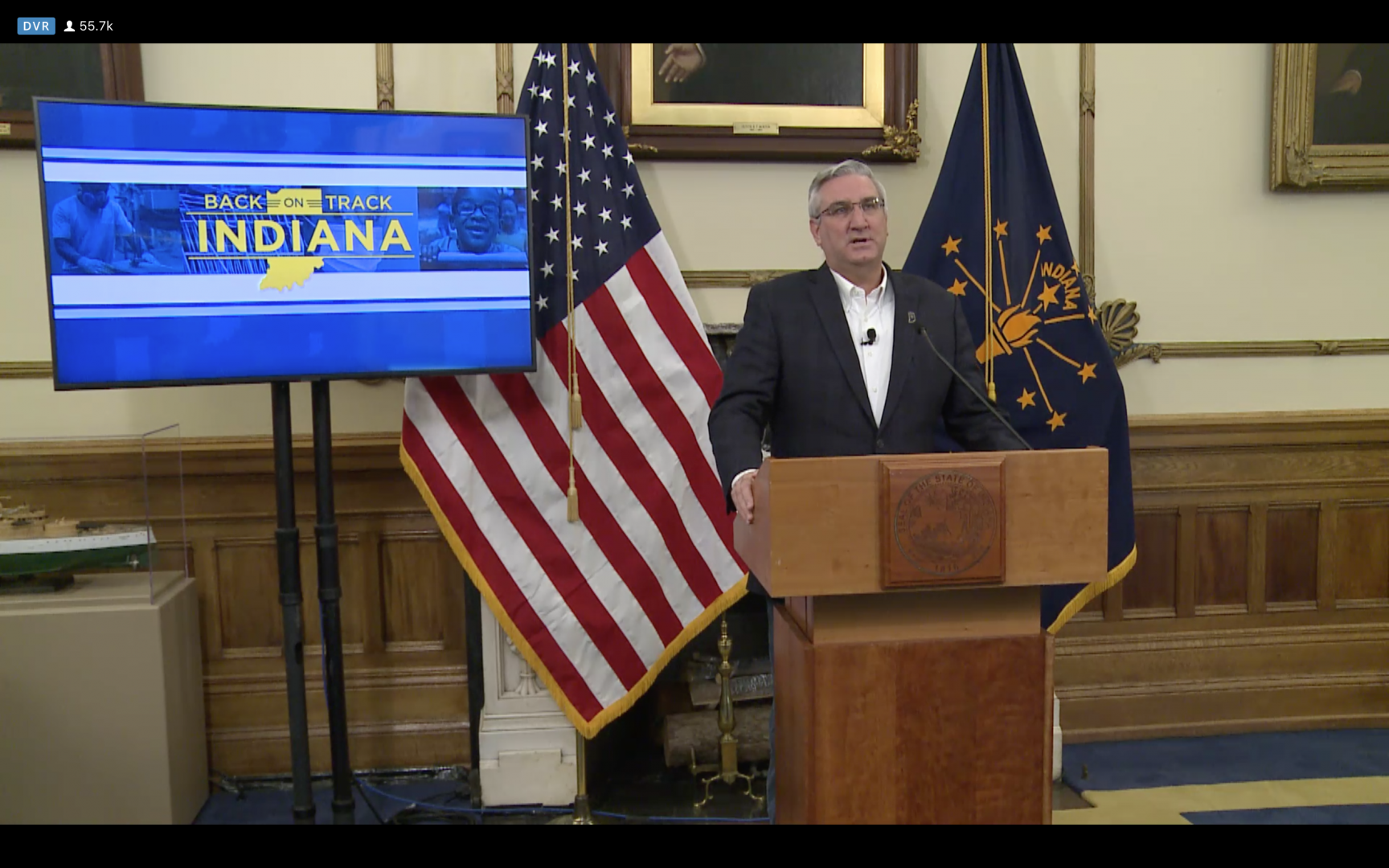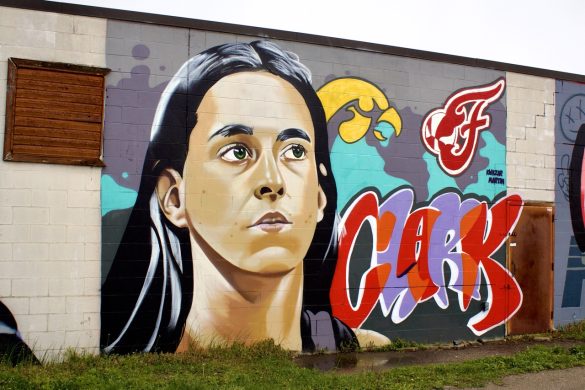Editor’s note: This story was updated at 3:45 p.m. on May 20, 2020 after Gov. Holcomb announced that Stage 3 of Indiana’s reopening plan would begin two days earlier than originally planned for most of the state, with the exception of Cass, Lake and Marion counties.
Indiana will begin reopening in stages, with an ultimate goal of having the state back on track by July 4, Gov. Eric Holcomb announced during a virtual press conference on May 1. The stages are part of the five-stage roadmap to safely reopen Indiana, “Back on Track Indiana.”
The next stage of the roadmap begins on May 4, which is when the recently extended stay-at-home order expires. The state has been under forms of stay-at-home orders since March 25, according to WFYI.
Indiana has had 19,295 positive cases of COVID-19 and 1,115 deaths reported as of May 2, according to the Indiana State Department of Health. 104,141 tests have been reported to ISDH as well.

There are four guiding principles that Indiana will use to determine how it will reopen segments of the state’s economy, according to Holcomb.
- The number of COVID-19 patients who are hospitalized statewide has decreased for 14 days. Holcomb said that COVID-19 patient admissions have decreased over the past 2 weeks.
- Indiana retains its surge capacity for critical care beds and ventilators. According to Holcomb, intensive care unit, or ICU, bed availability has remained above 40% and ventilator availability has remained above 70% for the last 2 weeks statewide.
- Indiana continues to have the ability to test all Hoosiers who are COVID-19 symptomatic. This includes healthcare workers, essential workers, first responders and others as listed on the Indiana State Department of Health’s website, according to a list of the principles posted on the Back on Track Indiana web portal.
- Health officials have systems in place to contact all individuals who test positive for COVID-19 and to complete contact tracing.
In order for the state to stay ahead of COVID-19, Indiana will be using a three-pronged approach to detect the virus, according to the Back on Track Indiana roadmap. The state will use robust testing, contact tracing to identify cases to prevent the virus’ spread and will develop a steady supply of personal protective equipment (PPE) to protect employees and consumers as they return to work.
Stage 1 of the reopening began on March 24, when Holcomb issued his first stay-at-home order, Holcomb said during the virtual press conference. Stage 2 begins for most of the state on May 4, when the stay-at-home order expires.
However, Marion, Lake and Cass counties will continue to be on Stage 1 on May 4. Marion and Lake counties may move on to Stage 2 on May 11, Holcomb said. This delay is in order to ensure that Indiana’s new testing and contact tracing programs are up and running in those counties. Cass County’s move is delayed due to a recent outbreak, Holcomb said. The state did not want to overwhelm the health care systems there as they deal with the outbreak. Cass County may move to Stage 2 on May 18, Holcomb said.
Under Stage 2, those who are 65 years-old or older, or are considered high-risk should stay at home as much as possible, according to the roadmap. Social gatherings can be increased to 25 people as long as they follow social distancing guidelines. Essential travel restrictions will also be lifted. Those who work in offices can return in small waves, however, they are encouraged to continue to work remotely.
Stage 2 Reopenings:
- Manufacturers, industrial operations and other infrastructures that have not been in operation may open following Occupational Safety and Health Administration and Center for Disease Control and Prevention guidelines.
- Retail and commercial businesses as long as they operate at 50% capacity.
- Shopping malls at 50% capacity, with indoor common areas such as food courts and sitting areas at 25% capacity.
- May 8: Worship services may convene in all counties, however, indoor services will be limited to 10 people or fewer and those 65 and older are being asked to stay home.
- May 11: Restaurants and bars can open at 50% capacity, however, bar seating will have to be closed.
- May 11: Hair salons, barber shops, nail salons, spas, tattoo parlors and other personal services by appointment only.
Stage 3 will begin on May 22 for most of the state, two days earlier than what was originally planned. Cass, Lake and Marion counties are the only exceptions, with Stage 3 beginning on June 1 for those counties. Holcomb announced the changes during a press conference on May 20.
Under this stage, those who are 65 years-old or older, or are considered high-risk should limit their exposure at work and in their communities, according to the roadmap. Face coverings are recommended and those who are working remotely should continue to do so if possible. Additionally, social gatherings of up to 100 people can occur, according to the roadmap.
Stage 3 Reopenings:
- Retail stores and malls may move up to 75% capacity as long as they maintain social distancing. Mall common areas, such as food courts and sitting areas, are limited to 50% capacity.
- Movie theaters may open at 50% capacity.
- Gyms and fitness centers may reopen open with restrictions that accommodate social distancing.
- Playgrounds, tennis courts, basketball courts and other similar facilities may reopen with social distancing guidelines.
- Campgrounds may reopen with social distancing and sanitation precautions.
On June 14, if the state is remaining on track, Stage 4 will begin. Under Stage 4, those who are 65 years-old or older or, are considered high-risk should follow social distancing guidelines and remain cautious at work and in their communities, according to the roadmap.
Face coverings will be optional and those who are working remotely should continue to do so if needed. Social gatherings of up to 250 people may take place as long as they follow CDC social distancing guidelines, according to the roadmap.
Stage 4 Reopenings:
- Zoos, museums, aquariums and other cultural, entertainment and tourism businesses may reopen at 50% capacity.
- State government buildings will reopen to the public.
- Office employees may resume work at full capacity.
- Retail stores and malls may open at full capacity with social distancing.
- Dining room service may open at 75% capacity.
- Bar seating in restaurants may open at 50% capacity.
- Bars and nightclubs may open at 50% capacity with social distancing.
- Recreational sports leagues and tournaments may resume.
- Large venues may open with social gatherings guidelines.
- Amusement parks, water parks and similar facilities may open at 50% capacity with limitations on the number of customers at one time.
If the state remains on track, on July 4, Stage 5 will begin. Under Stage 5, those who are 65 years-old or older, or are considered high-risk should continue to follow social distancing guidelines and remain cautious at work and in their communities, according to the roadmap.
Face coverings will be optional, along with working remotely. Social gatherings of over 250 people may take place as long as they follow CDC social distancing guidelines. In July, the state will also determine how K-12 schools will operate for the upcoming school year, according to the roadmap.
Stage 5 Reopenings:
- Retail stores and malls will be allowed to operate at full capacity, along with restaurants, bars, nightclubs and personal services.
- Restrictions at gyms and fitness facilities will be lifted.
- Conventions, sports events, fairs, festivals, the Indiana State Fair and similar events may be allowed to resume.
- Restrictions will be lifted at amusement parks, water parks and similar facilities with social distancing guidelines.
Holcomb said during the press conference that as the state lifts restrictions and people return to work, participate in activities, or go to stores and restaurants, the number of COVID-19 cases will increase. If Indiana cannot meet these principles, portions of the state, or all of the state might need to slow down on moving forward or return to an earlier stage of his stay-at-home order, he said.
“This is up to each of us, and all of us,” Holcomb said during the press conference.
While Indiana is reopening, local governments can issue guidelines that are stricter than the state’s, Holcomb said. On April 30, Indianapolis Mayor Joe Hogsett extended Marion County’s stay-at-home order to May 15, according to a press release from the city of Indianapolis.
Hogsett said in a press release on April 30 that after talking with state leaders and community stakeholders that the challenges Indianapolis faces are unique. The city is filled with large venues, densely populated neighborhoods and active business centers, he said.
“To ensure that we see continued progress in our fight against this virus, we must recommit to our social distancing efforts even as we plan for the future,” Hogsett said in an April 30 press release.
Following Holcomb’s announcement of Back on Track Indiana, Hogsett tweeted his thanks for Holcomb, Indiana State Health Commissioner Kris Box and the city’s partners at the state for their work in providing the new policy recommendations.
For more details on the governor’s plans, go to www.backontrack.in.gov.









